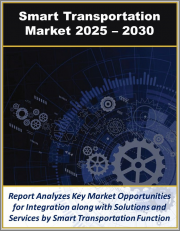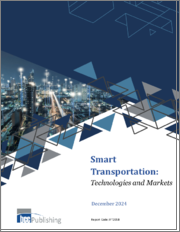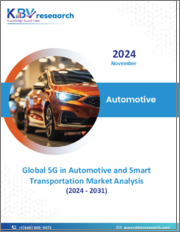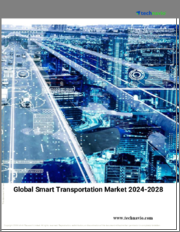
|
시장보고서
상품코드
1685923
스마트 교통 : 시장 점유율 분석, 산업 동향, 통계, 성장 예측(2025-2030년)Smart Transportation - Market Share Analysis, Industry Trends & Statistics, Growth Forecasts (2025 - 2030) |
||||||
스마트 교통 시장 규모는 2025년에 356억 5,000만 달러, 2030년에는 495억 1,000만 달러에 달할 것으로 예측됩니다. 예측 기간(2025년-2030년) CAGR은 6.79%를 나타낼 전망입니다.

교통량 증가, 온실가스의 영향 삭감을 목표로 한 정부의 대처, 도시 프로젝트 증가, 메가 시티의 대두, 도시화, 인구 증가 등이 시장 성장을 가속하는 요인으로 되어 있습니다. 7억명이 도시에 거주하게 됩니다. 이러한 예측은 생태학적으로도 경제적으로도 지속 가능한 새로운 인도를 계획, 설계, 건설할 수 없는 기회가 됩니다.
주요 하이라이트
- 도시화의 진전은 세계의 도시가 복잡해지고 있음을 반영하고 있으며, 운송 요구도 그 중 하나입니다. 교통 시장이 직면하는 주요 과제 중 하나는 이러한 복잡성을 해결하는 것입니다. IoT와 연동 장치 증가 추세는 예측 기간 동안 스마트 시티 프로젝트와 함께 계속됩니다. 특히 스마트홈, 스마트 미터, 스마트 교통, 스마트 조명 등 IoT를 이용하여 상호 통신하는 연계 제품의 이용 증가가 시장 확대의 원동력이 될 것으로 예상됩니다. 게다가 2025년까지 26개 이상의 스마트 시티가 탄생했으며 그 대부분이 북미와 유럽에 존재할 것으로 예측되고 있으며, AI와 IoT 기술의 스마트 시티 채용이 큰 추진력이 되고 있습니다.
- 혁신적인 도시 개발의 주요 목적 중 하나는 교통을 포함한 스마트 이동성입니다. 효율적이고 유연한 통합 교통 네트워크 구축은 스마트 이동성에 필수적입니다. 스마트 모빌리티는 현대 도심에서 중요한 개발 드라이버로 관광객과 주민들의 일상 생활을 향상시킬 수 있습니다. 2040년까지 도시는 세계 인구의 65%를 수용할 것으로 예상됩니다.
- 도시의 이동성 관리는 도보 및 자전거와 같은 건강한 교통 수단을 선호합니다. 모빌리티 매니지먼트는 또한 이산화탄소 배출량을 최소화하고 지역사회에 최적의 교통 흐름 분석을 제공합니다.
- 교외와 농촌에서 도시로의 인구 이전이 급격히 증가하고 대도시 중심부로의 인구 집중도 마찬가지로 증가하고 있기 때문에 교통 정체가 증가하고 있습니다. 도시의 정체는 도시의 밀도가 높아짐에 따라 부적절한 도로 설계와 부적절한 도시 계획에 도움이 됨에 따라 증가하고 있습니다. 예를 들어 2022년 미국의 평균 자동차 이용자는 교통 정체로 51시간, 즉 매주 약 1시간을 낭비했습니다. 모빌리티 분석회사 인릭스의 '2022년 세계교통 스코어카드'에 따르면, 이는 이전보다 15시간 길었고, 정체로 낭비된 시간은 모두 전형적인 미국 자동차 이용자에게 869달러의 손실이 됩니다.
- 게다가 2022년 4월, 전자정보기술부(MeitY)는 인도의 교통 시나리오를 개선하기 위해 InTranSE-II 프로그램의 일환으로 고도 도로교통시스템(ITS) 하에서 여러 용도를 시작했습니다. Advanced Computing)과 IIT-M(Indian Institute of Technology Madras)의 공동 사업으로 설계되었습니다.
- 그러나, 표준화된 전략의 필요성으로부터, 소프트웨어, 하드웨어, 모바일 네트워크 컴퍼넌트 등, 많은 측면이 혼재하는 스마트 교통은 복수의 제조업체가 제조하고 있어, 호환성에 우려가 있습니다. 또한, 통신 프로토콜은 나라에 의해 크게 다르기 때문에 제조업체에 있어서는 자사 제품이 세계에서 받아들여질 것인가 하는 과제가 있습니다.
스마트 교통 시장 동향
도시화와 인구 증가가 시장을 견인
- 도시화율과 메가시티 증가와 함께 인구가 증가하고 있는 것이, 시장을 견인하는 주된 요인입니다. 또한, 인구 증가와 도시화에 수반해, 많은 도시가 교통의 과제에 직면하기 때문에 스마트 교통 수요가 높아집니다. 예를 들면, 인구 문제 연구소에 의하면, 2022년의 세계의 도시화율은 57%였습니다.
- 세계의 도시 인구의 절반 이상은 아시아에 살고 있으며, 인도와 중국처럼 도시 지역에서 이미 약 10억 명이 살고 있는 국가도 있습니다. 이 복잡성을 해결하는 것은 이러한 지역의 운송 시장이 직면하는 중대한 과제 중 하나입니다.
- 도시의 인구 증가는 대중 교통 인프라를 현저하게 압박합니다. 화는 격렬한 교통 혼잡, 심각한 안전 문제, 도시 격차의 확대를 가져오고 있습니다.
- 게다가 도시와 거대도시에서는 교통체증 증가 외에도 오염물질 배출량 증가와 연료자원 고갈 등 대도시 전체의 행복에 악영향을 미치는 교통관련 문제에 직면하고 있습니다.
- 또한 도시 교통은 모든 도시에서 시민의 삶의 질을 향상시키기 위해 필수적입니다.
아시아태평양이 가장 빠른 성장을 기록할 전망
- 중국은 14차 5개년 계획(2021-2025년) 중 최근 종합적인 교통 시스템의 개요를 제시했습니다. 2025년까지 중국은 지능적이고 친환경적인 교통 수단을 추구하는 데 있어 성과를 거둘 것이며, 교통 산업의 전반적인 역량, 서비스 품질, 효율성에서도 상당한 진전을 이룰 것입니다.
- 스마트 교통은 IoT(사물인터넷)로 대표되는 스마트 교통 네트워크의 도입으로 일본에서 급속히 확대되고 있습니다.
- 호주에서는 교통 체증을 완화하고 안전성과 교통 상황을 향상시키기 위해 운전자와 인프라 사업자와 상호 작용하는 교통 관리 기술의 개발이 진행되고 있습니다.
- 기타 아시아태평양은 싱가포르, 인도, 한국 등 많은 신흥국으로 구성되어 있습니다.
- 또한 아시아태평양 국가들은 시장 도입을 위한 투자와 제휴를 통해 서로 돕고 있습니다.
스마트 교통 산업 개요
스마트 교통 산업 시장 침투율은 상대적으로 낮기 때문에 기업은 특정 부문에 맞는 제품과 솔루션을 제공하고, 개별 고객을 위해 제품을 맞춤화하여 차별화와 가격 실현을 강화하는 태세를 마련하고 있습니다. 시스코, SAP SE, IBM 등 스마트 교통 및 비즈니스의 주요 진출기업은 신분야에서의 사업 확대에 주력하고 있습니다. 이들 기업은 스마트 교통 분야의 제품 라인을 확대하기 위해 참신하고 독창적인 아이디어를 개발해 온 실적이 있습니다. 전반적으로 업계 경쟁업체 간의 적대관계는 예측 기간 동안 증가할 것으로 예상됩니다.
- 2023년 8월 - 히타치 레일의 세계 최초의 디지털 교통 앱이 제노바의 대중교통 인프라 전체를 연결하는 본격적인 상용 서비스에 들어갑니다. 이 서비스는 시내의 공공 및 민간 교통 시스템과 연계하여 제노바에 거주하거나 방문하는 모든 사람이 여러 교통 수단에 의한 이동을 저렴하게 계획, 예약, 결제할 수 있습니다. 제노바의 대중교통과 민간교통을 통합함으로써, 이용자는 복수의 교통수단을 이용한 여행의 계획, 예약, 지불이 가능하게 됩니다. 663대의 버스, 2500개의 버스 정류장, 지하철이 연간 1,500만 명의 승객이 이용합니다.
- 2022년 10월 - 지멘스와 16개 파트너가 2024년 말까지 예정되어 지역 철도의 자율운행에 있어서의 인공지능을 강화하는 프로젝트를 개시. 이 프로젝트는 독일 정부 투자의 'safe.trAIn' 프로젝트 내에서 2,300만 유로(2,500만 달러)의 예산을 제공합니다. 이 고도로 관리되고 표준화된 환경의 요구사항을 충족함으로써 지역 철도 운송의 효율성과 지속가능성을 크게 향상시킬 수 있습니다.
기타 혜택
- 엑셀 형식 시장 예측(ME) 시트
- 3개월간의 애널리스트 지원
목차
제1장 서론
- 조사의 전제조건과 시장 정의
- 조사 범위
제2장 조사 방법
제3장 주요 요약
제4장 시장 인사이트
- 시장 개요
- 업계의 매력도 - Porter's Five Forces 분석
- 공급기업의 협상력
- 구매자의 협상력
- 신규 참가업체의 위협
- 경쟁 기업간 경쟁 관계
- 대체품의 위협
- 산업 밸류체인 분석
- 거시 경제 동향이 시장에 미치는 영향
- 기술 스냅샷
제5장 시장 역학
- 시장 성장 촉진요인
- 도시화의 진전과 메가시티 증가, 인구 증가
- 교통 인프라 강화를 위한 정부의 대처
- 시장 성장 억제요인
- 도입에 필요한 자본의 높이
제6장 시장 세분화
- 용도별
- 교통관리
- 교통 안전 및 보안
- 주차장 관리
- 대중교통기관
- 자동차 텔레매틱스
- 화물 수송
- 기타 용도
- 제품 유형별
- 고도 여행자 정보 시스템(ATIS)
- 고도 운송 관리 시스템(ATMS)
- 고도교통요금시스템(ATPS)
- 고도 대중교통시스템(APTS)
- 협력 차량 시스템
- 지역별
- 북미
- 미국
- 캐나다
- 유럽
- 영국
- 독일
- 프랑스
- 아시아
- 중국
- 일본
- 호주 및 뉴질랜드
- 라틴아메리카
- 멕시코
- 브라질
- 중동 및 아프리카
- 아랍에미리트(UAE)
- 남아프리카
- 사우디아라비아
- 북미
제7장 경쟁 구도
- 기업 프로파일
- Cisco Systems Inc.
- SAP SE
- IBM Corporation
- AVEVA Group PLC
- Siemens Corporation
- Oracle Corporation
- Alstom
- Advantech Co. Ltd
- Orange SA
- Huawei Technologies Co. Ltd
- Hitachi Ltd
제8장 투자 분석
제9장 시장의 미래
SHW 25.04.23The Smart Transportation Market size is estimated at USD 35.65 billion in 2025, and is expected to reach USD 49.51 billion by 2030, at a CAGR of 6.79% during the forecast period (2025-2030).
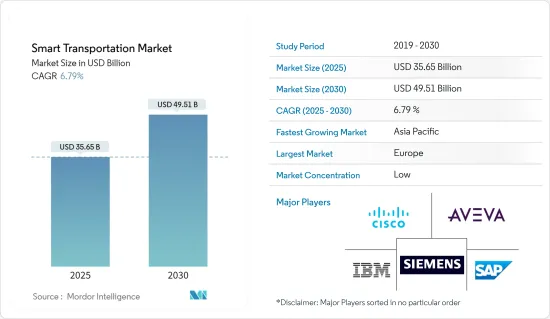
Increasing traffic volume, government initiatives aimed at decreasing the effects of greenhouse emissions, rising city projects, and the rise of megacities, urbanization, and population are some factors driving the market growth. The UN forecasts estimate that more than 70% of the world population will be urbanized by 2030, wherein 700 million people will reside in cities in India. These predictions serve as a unique opportunity to plan, design, and build an ecologically and economically sustainable new India. Additionally, urbanization has boosted national economies across the globe, as 75% of global economic production takes place in the cities.
Key Highlights
- Increasing urbanization reflects the growing complexities in cities worldwide, with transportation needs being one of them. One of the primary issues the transportation market faces is resolving this complexity. The trend of a rising number of IoT and linked devices will continue with smart city projects during the projection period. The increased use of linked products like smart homes, smart meters, smart transportation, and smart lighting, among others that use IoT to communicate with one another, is expected to drive market expansion. In addition, it is predicted that by 2025, there will be more than 26 smart cities, with the majority existing in North America and Europe, delivering a significant drive to AI and IoT technology for adoption in smart cities.
- One of the primary objectives of innovative city development is smart mobility, which includes transportation. Creating efficient, flexible, and integrated transportation networks is vital to smart mobility. Smart mobility is a significant development driver in modern urban centers and may improve tourists' and inhabitants' everyday lives. By 2040, cities are expected to accommodate 65% of the world's population.
- Healthy modes of transportation, such as walking and cycling, are prioritized in urban mobility management. Mobility management also minimizes carbon emissions and provides communities with optimal traffic flow analysis.
- Traffic congestion is increasing due to exponential growth in suburban and rural populations relocating to cities and an equivalent increase in population concentration around metropolitan centers. Vehicle congestion in cities has increased as cities have grown in density, assisted by insufficient roadway designs and bad urban planning. For example, in 2022, the average American motorist wasted 51 hours in traffic congestion, or approximately an hour each week. This is 15 hours longer lost to traffic than previously, and all that time squandered in traffic jams costs the typical American motorist USD 869 in lost time, according to the mobility analytics firm Inrix's 2022 Global Traffic Scorecard.
- Further, in April 2022, the Ministry of Electronics and Information Technology (MeitY) launched several applications under the Intelligent Transportation System (ITS) as part of the InTranSE- II program to improve India's traffic scenario. An indigenous Onboard Driver Assistance and Warning System (ODAWS), Bus Signal Priority System, and Common SMart IoT Connectiv (CoSMiC) software were designed as a joint enterprise by the Centre for Development of Advanced Computing (CDAC) and the Indian Institute of Technology Madras (IIT-M). Mahindra and Mahindra was the industrial collaborator for the project. The government declared that ODAWS aims to improve the highway infrastructure as the number of vehicles and road speed has increased, exacerbating safety concerns.
- However, due to the need for a standardized strategy, smart transportation mixed with numerous aspects, such as software, hardware, and mobile network components, are produced by multiple manufacturers, resulting in compatibility concerns. Furthermore, communication protocols range significantly among nations, posing challenges for manufacturers in terms of worldwide acceptance of their products.
Smart Transportation Market Trends
Rise of Urbanization, and Population would Drive the Market
- The population growth, coupled with the increasing urbanization rate and megacities, is the primary factor driving the market. Moreover, as the population grows and urbanizes, many cities will face transportation challenges, thus driving the demand for smart transportation. For instance, according to the Population Reference Bureau, in 2022, the degree of urbanization worldwide was 57%. North America was the region with the highest level of urbanization, with over four-fifths of the population residing in urban areas.
- More than half the world's urban population resides in Asia, where some countries, like India and China, already have about a billion people living in cities alone. The other regions with relatively high urban populations are North America, Europe, and Africa. Increasing urbanization indicates the rising complexities in the transportation of cities worldwide. Resolving these complexities is one of the significant challenges faced by the transport markets across these areas. For instance, according to the United Nations, people living in urban areas are expected to reach 68% by 2050.
- Urban population growth will significantly pressure public transport infrastructure. Residents of big cities will expect public transport that is fast, efficient, affordable, safe, and environmentally friendly. Delivering such transportation infrastructure will be one of the critical challenges confronting future cities. Furthermore, rapid urbanization has brought heavy traffic congestion, serious safety issues, and growing urban inequality. Smart transportation solutions have gained significant traction in the past few years across many highly urbanized cities to overcome such challenges by delivering real-time travel and traffic information with resilient network control.
- Furthermore, besides increasing traffic congestion, the urban areas and megacities face several other transport-related problems, such as growing emissions of pollutants and depleting fuel resources that adversely impact the overall well-being of any major city. To make transport management more effective, several cities worldwide are trying to create intelligence into existing systems by adopting smart transportation systems, which is expected to drive the market's growth at a rapid pace.
- Moreover, urban transportation is becoming crucial for a better quality of life for citizens in any city. Today cities worldwide are expanding to incredible sizes. The rising maturation rate of megacities worldwide and multiple innovations taking place in the technology field for the transportation sector are further driving the market's growth.
Asia Pacific is Expected to Register Fastest Growth
- China outlined a recent comprehensive transportation system in the 14th Five-Year Plan (2021-2025). According to the circular, by 2025, China will have made achievements in pursuing intelligent and green transportation, as well as significant advances in overall competence, service quality, and efficiency of the transportation industry. This plan aims to improve the transportation industry's roads, trains, ports, and waterways and the technology and human resources involved. As a result, this will support growth in urbanization, consumer demand, and factor supply movements.
- Smart transportation is quickly expanding in Japan with the introduction of smart transportation networks, such as the Internet of Things (IoT). Smart transportation networks require IoT architecture, which includes technologies such as the cloud, sensors, and data communication. Rapid improvements in recent years have made it feasible to enhance device communication.
- Australia has been developing traffic management technologies interacting with drivers and infrastructure operators to reduce traffic congestion and enhance safety and traffic conditions. The country has a diverse and complex transportation infrastructure network, creating an opportunity for the market players in the country due to the increasing demand for smart transportation technologies.
- The rest of Asia-Pacific consists of many emerging countries, including Singapore, India, and South Korea. The emergence of smart cities in these countries is increasing the adoption of intelligent technologies in transportation to enhance traffic efficiencies, creating a market opportunity for technology providers.
- Countries in the region are also helping each other by investing and partnering in the market adoption in Asia-Pacific. For instance, in December 2022, India and South Korea agreed to a loan of INR 1,495 crore (USD 183.14 million) from the Economic Development Cooperation Fund (EDCF) of the Republic of Korea to construct an intelligent transport system on the Nagpur-Mumbai Expressway.
Smart Transportation Industry Overview
As the market penetration of the smart transportation industry is relatively low, firms are poised to offer products and solutions that are tailor-made to specific segments and even customize products for individual customers, enhancing differentiation and price realization. The major participants in the smart transportation business, like Cisco, SAP SE, IBM, etc., are focusing on growing their operations in new areas. These companies have a track history of developing novel and inventive ideas to expand their product lines in the smart transportation sector. Overall, the industry's intensity of competitive rivalry is expected to be high during the forecast period.
- August 2023 - Hitachi Rail's world-first digital transport app enters full commercial service to connect Genoa's entire public transport infrastructure, The service, in conjunction with the city's public and private transport systems, allows any person living or visiting Genoa to plan, book and pay for multimodal journeys at a reduced price. By integrating the city's public and private transport systems, the service provides users with the possibility to plan, book and pay for multimodal journeys. 663 buses, 2500 bus stops and the metro line uses 15 million passengers per annum.
- October 2022 - Siemens and 16 partners started a project likely to last through the end of 2024 to enhance artificial intelligence in the autonomous operation of regional trains. A budget of EUR 23 million (USD 25 million) within the German government-funded "safe.trAIn" project is available for this project. Meeting the requirements in this highly governed and standardized environment can significantly improve the efficiency and sustainability of regional railway transportation.
Additional Benefits:
- The market estimate (ME) sheet in Excel format
- 3 months of analyst support
TABLE OF CONTENTS
1 INTRODUCTION
- 1.1 Study Assumptions and Market Definition
- 1.2 Scope of the Study
2 RESEARCH METHODOLOGY
3 EXECUTIVE SUMMARY
4 MARKET INSIGHTS
- 4.1 Market Overview
- 4.2 Industry Attractiveness - Porter's Five Forces Analysis
- 4.2.1 Bargaining Power of Suppliers
- 4.2.2 Bargaining Power of Buyers
- 4.2.3 Threat of New Entrants
- 4.2.4 Intensity of Competitive Rivalry
- 4.2.5 Threat of Substitute Products
- 4.3 Industry Value Chain Analysis
- 4.4 Impact of Macroeconomic Trends on the Market
- 4.5 Technology Snapshot
5 MARKET DYNAMICS
- 5.1 Market Drivers
- 5.1.1 Rise of Urbanization and Increasing Mega Cities and Increasing Population
- 5.1.2 Government Initiatives to Enhance the Transportation Infrastructure
- 5.2 Market Restraints
- 5.2.1 High Capital Required for Deployment
6 MARKET SEGMENTATION
- 6.1 By Application
- 6.1.1 Traffic Management
- 6.1.2 Road Safety and Security
- 6.1.3 Parking Management
- 6.1.4 Public Transport
- 6.1.5 Automotive Telematics
- 6.1.6 Freight
- 6.1.7 Other Applications
- 6.2 By Product Type
- 6.2.1 Advanced Traveler Information Systems (ATIS)
- 6.2.2 Advanced Transportation Management Systems (ATMS)
- 6.2.3 Advanced Transportation Pricing Systems (ATPS)
- 6.2.4 Advanced Public Transportation Systems (APTS)
- 6.2.5 Cooperative Vehicle Systems
- 6.3 By Geography
- 6.3.1 North America
- 6.3.1.1 United States
- 6.3.1.2 Canada
- 6.3.2 Europe
- 6.3.2.1 United Kingdom
- 6.3.2.2 Germany
- 6.3.2.3 France
- 6.3.3 Asia
- 6.3.3.1 China
- 6.3.3.2 Japan
- 6.3.4 Australia and New Zealand
- 6.3.5 Latin America
- 6.3.5.1 Mexico
- 6.3.5.2 Brazil
- 6.3.6 Middle East and Africa
- 6.3.6.1 United Arab Emirates
- 6.3.6.2 South Africa
- 6.3.6.3 Saudi Arabia
- 6.3.1 North America
7 COMPETITIVE LANDSCAPE
- 7.1 Company Profiles
- 7.1.1 Cisco Systems Inc.
- 7.1.2 SAP SE
- 7.1.3 IBM Corporation
- 7.1.4 AVEVA Group PLC
- 7.1.5 Siemens Corporation
- 7.1.6 Oracle Corporation
- 7.1.7 Alstom
- 7.1.8 Advantech Co. Ltd
- 7.1.9 Orange SA
- 7.1.10 Huawei Technologies Co. Ltd
- 7.1.11 Hitachi Ltd









